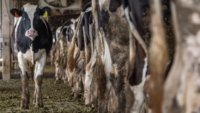UK Reports Decade-Low Antibiotic Sales for Use in Food Animals, Decreasing AMR

Image credit: aleksandarlittlewolf via Freepik
UK sales of antibiotics for use in food-producing animals is at a 10-year-low, according to the latest report from the UK Veterinary Medicines Directorate. The report also shows decreasing levels of antimicrobial resistance (AMR) in pathogens from livestock and poultry.
The UK-Veterinary Antimicrobial Resistance and Sales Surveillance (UK-VARSS) report brings together national data on antibiotic sales, antibiotic use, and AMR. This year’s report was published during World AMR Awareness Week, which is recognized during November every year to highlight the urgent threat to global public health posed by AMR.
Antibiotic Sales
Although the latest report shows no change in the sales of veterinary antibiotics for use in livestock and poultry between 2022 and 2023 (25.7 milligrams per kilogram [mg/kg]), antibiotic sales for food-producing animals remain 59 percent lower than reported in 2014 (62.3 mg/kg). More than 60 percent of all antibiotics sold for use in food-producing animals were either tetracyclines (33 percent) or penicillins (28 percent).
Sales of critically important antibiotics for use in food-producing animals (i.e., fluoroquinolones, third- and fourth-generation cephalosporins, and colistin) remain at very low levels (0.11 mg/kg), accounting for less than 0.5 percent of total sales, and representing an 84 percent decrease compared with sales in 2014 (0.67 mg/kg). No sales of colistin for use in food-producing animals were recorded in 2023, compared to 0.12 mg/kg in 2014.
Antibiotic Use
Pigs were administered the most antibiotics out of any food-producing animals in the UK, with 84.8 mg/kg used—an increase of 13 mg/kg compared to 2022. Still, the use of antibiotics in pigs is down 69 percent from 2014. Broiler chickens followed pigs, with 13.5 mg/kg total antibiotics administered, representing a 0.5 mg/kg decrease from 2022 and a 72 percent decrease from 2014.
In 2023, 19.9 mg/kg antibiotics were administered to salmon, up by 1.4 mg/kg since 2022 and by 24 percent since 2014. Salmon is the only food-producing animal to see an increase in antibiotic use since 2014, with the rest of the monitored animal categories seeing significant decreases throughout the decade, ranging from 51 percent to 97 percent.
AMR
The UK-VARSS report monitors AMR in pathogens isolated from healthy pigs and poultry at slaughter, and the latest report is the first to include results from AMR surveillance pilots in milk from dairy cattle, beef cattle, and sheep, carried out under the UK Food Standards Agency’s (FSA’s) Pathogen Surveillance in Agriculture, Food, and Environment (PATH-SAFE) program.
There have been significant improvements in AMR since reporting began in 2014–2015. The percentage of Escherichia coli isolates (from pigs and chickens) showing full susceptibility to the panel of tested antibiotics is at a new high of 43 percent, which is more than double the rate seen in 2014–2015. Additionally, the percentage of multidrug-resistant isolates (from pigs and chickens) is at a new low of 27 percent.
Based on PATH-SAFE testing, full antimicrobial susceptibility among E. coli isolated from sheep and dairy cattle is more than 87 percent and more than 80 percent, respectively. However, there was also a significant percentage of E. coli isolated from beef cattle that expressed genes carrying resistance to critical third- and fourth-generation cephalosporins.
The UK-VARSS report also includes veterinary clinical surveillance data, providing AMR information for pathogens isolated from diagnostic samples. This data is not representative of the UK’s wider animal populations.
Of the 1,168 clinical E. coli isolates tested for AMR, 18 percent showed resistance to four or more individual antibiotics, although overall resistance has decreased since 2014. Of the 5,513 clinical Salmonella isolates tested, 73 percent were fully susceptible to antibiotics, while 14 percent were resistant to four or more antibiotics.
Looking for a reprint of this article?
From high-res PDFs to custom plaques, order your copy today!






